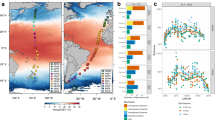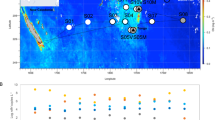Abstract
Although there are 107–109 bacteria per litre of sea water and up to 50% of marine primary productivity passes through them1, no direct information exists on small-scale spatial distributions of individual bacteria. It has been proposed that bacteria cluster around participate nutrient sources2–4, but evidence for this is indirect, based on the presence of chemo taxis in isolates and a broad range—10−9–10−4 M—of uptake affinity constants3. These data have led to the suggestion that there exist oceanic microzones having utilizable dissolved organic carbon (uDOC) orders of magnitude above background concentrations4. Here, our calculations of size (10−1 cm), utilizable DOC concentrations (10−9–10−7 M) and lifetimes of these nutrient gradients suggest that bacteria cluster around phytoplankton in low-turbulence layers and sheets comprising the thermocline. There, phytoplankton may sink slowly enough for bacteria to keep up with them, and mixing times are long enough to allow nutrient gradients to develop and bacteria to track these gradients. However, very favourable conditions are required for micro zone concentrations to be significantly above background.
This is a preview of subscription content, access via your institution
Access options
Subscribe to this journal
Receive 51 print issues and online access
$199.00 per year
only $3.90 per issue
Buy this article
- Purchase on Springer Link
- Instant access to full article PDF
Prices may be subject to local taxes which are calculated during checkout
Similar content being viewed by others
References
Fuhrman, J. A. & Azam, F. Mar. Biol 66, 109–120 (1982).
Bell, W. H. & Mitchell, R. Biol. Bull. 143(2), 265–277 (1972).
Azam, F. & Hodson, R. E. Mar. Ecol. Prog. Ser. 6, 213–222 (1981).
Azam, F. & Ammerman, J. W. Flows of Energy and Nutrients in Marine Ecosystems (ed. Fasham, M. J. R.) (Plenum, New York, 1984).
Sharp, J. J. Limnol. Oceanogr. 22(3), 381–399 (1977).
Lancelot, C. Mar. Ecol. Prog. Ser. 1, 179–186 (1979).
Parsons, T. R. et al. Biological Oceanographic Processes (Pergamon, New York, 1977).
Chrost, R. H. & Faust, M. A. J. Plankton Res. 5(4), 477–493 (1983).
Fogg, G. E. Physiology and Biochemistry of Algae (ed. Lewin, R. A.) (Academic, New York, 1963).
Carslaw, H. S. & Jaeger, J. C. Conduction of Heat in Solids (Oxford University Press, 1959).
Carlucci, A. F., Craven, D. B. & Henrichs, S. M. Appl. envir. Microbiol. 48, 165–170 (1984).
Mopper, K. et al. Mar. Chem. 10, 55–66 (1980).
Weast, R. C. (ed.) Handbook of Chemistry and Physics 56th edn (CRC Press, Cleveland, 1975).
Woods, J. D. Met. Mag., Lond. 97, (1148), 65–72 (1968).
Berg, H. C. & Purcell, E. M. Biophys. J. 20, 193–219 (1977).
DeLisi, C. Nature 289, 322–323 (1981).
McNab, R. M. & Koshland, D. E. Jr., Proc. natn. Acad. Sci. U.S.A. 69, 2509–2512 (1972).
Berg, H. C. Nature 254, 389–392 (1975).
Adler, J. Science 166, 1588–1597 (1969).
Dahlquist, F. W. et al. Nature new Biol. 236, 120–123 (1972).
Bienfang, P. K. Mar. Biol. 61, 69–77 (1980).
Lee, R. E. Phycology (Cambridge University Press, 1980).
Hobson, L. A. & Lorenzen, C. J. Deep Sea Res. 19, 297–306 (1972).
Woods, J.D. & Fosberry, G.G. Underwat. Ass. Rep. 5–19 (1966–67).
Lehman, J. T. & Scavia, D. Science 216, 729–730 (1982).
Jackson, G. A. Nature 284, 439–441 (1980).
Batchelor, G. K. The Theory of Homogeneous Turbulence (Cambridge University Press, 1956).
Ozmidov, R. V. Izv. Akad. Nauk. SSR 1, 439–448 (1965). (Engl. transl. Izvestiya atmos. Oceanic Phys. 1, 257–261 (1965).
Gregg, M. C. J. phys. Oceanogr. 14, 588–711 (1984).
Author information
Authors and Affiliations
Rights and permissions
About this article
Cite this article
Mitchell, J., Okubo, A. & Fuhrman, J. Microzones surrounding phytoplankton form the basis for a stratified marine microbial ecosystem. Nature 316, 58–59 (1985). https://doi.org/10.1038/316058a0
Received:
Accepted:
Issue Date:
DOI: https://doi.org/10.1038/316058a0
This article is cited by
-
Bacteria contribute exopolysaccharides to an algal-bacterial joint extracellular matrix
npj Biofilms and Microbiomes (2024)
-
Chemotaxis increases metabolic exchanges between marine picophytoplankton and heterotrophic bacteria
Nature Microbiology (2023)
-
Can diatom girdle band pores act as a hydrodynamic viral defense mechanism?
Journal of Biological Physics (2019)
-
Zooming in on the phycosphere: the ecological interface for phytoplankton–bacteria relationships
Nature Microbiology (2017)
-
Advancing microbial sciences by individual-based modelling
Nature Reviews Microbiology (2016)
Comments
By submitting a comment you agree to abide by our Terms and Community Guidelines. If you find something abusive or that does not comply with our terms or guidelines please flag it as inappropriate.



